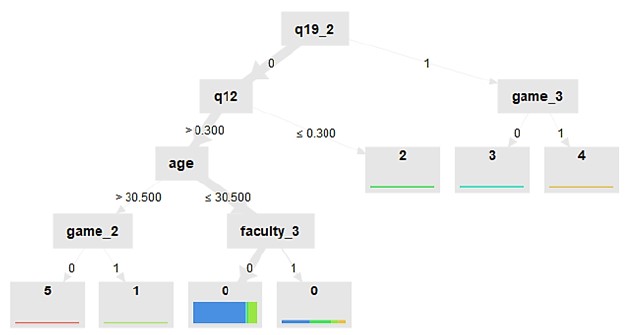Determining the Distinctiveness of Learners with Outlier Detection Ensembles
คำสำคัญ:
Outliers Detection, Ensembles Method, Decision Trees, Learner Distinctiveness, Gamification Designบทคัดย่อ
Gamification is the application of game design principles and elements to non-game contexts. It has been increasingly used to engage and motivate learners. A clear understanding of learners’ characteristics is a key success of gamification. Understanding the distinctiveness of the learners' behaviors enables gamification design to encompass all types of participants. This paper then proposes a methodology to assist gamification design in identifying distinctive individual learners within a group. The proposed methodology adopts ensembles of outlier detection techniques to examine how much individual learners differ quantitatively from the group, and utilizes decision tree classifiers to identify the factors contributing to the distinctiveness. The outcomes of these methods are presented in the if-then rules, which assist the interpretability of the discovered insights. This method enables educators and gamification designers to personalize gamified learning environments by focusing on unique learner characteristics.
เอกสารอ้างอิง
Aggarwal, C. C. (2017). Outlier analysis,2nded., Bangkok, Thailand: Fophrinting Chamkat.pp.113-140.
Breunig, M. M., Kriegel, H. P., Ng, R. T., & Sander, J. (2000). LOF: identifying density-based local outliers. In Proceedings of the 2000 ACM SIGMOD international conference on Management of data(pp. 93-104).
Chandola, V., Banerjee, A., & Kumar, V. (2009). Anomaly detection: A survey, ACM computing surveys, 41(3).
Goldstein, M., & Dengel, A. (2012). Histogram-based outlier score (hbos):A fast unsupervised anomaly detection algorithm. KI-2012: Poster and Demo Track of the 35th German Conference on Artificial Intelligence (KI-2012)(pp. 59-63).
Greene, K. (2023). Big Data and Gamification: How to Play It Smart. Retrieved January, 2023, from https://emfluence.com/blog/big-data-and-gamification-how-to-play-it-smart
Greene, K. (2024). The 9 Quantic Gamer Types, 2024, from https://quanticfoundry.com/gamer-types/
Han, S., Hu, X., Huang, H., Jiang, M., & Zhao, Y. (2022). Adbench: Anomaly detection benchmark. Advances in Neural Information Processing Systems, 36th Conference on Neural Information Processing Systems (NeurIPS) Track on Datasets and Benchmarks(pp. 32142-32159).
He, Z., Xu, X., & Deng, S. (2003). Discovering cluster-based local outliers. Pattern recognition letters, 24(9-10), 1641-1650.
Inchamnan, W. (2023). Gamification Pedagogy Trigger Design for Creative Experiences in Metaverse Class Room. Journal of Applied Science and Emerging Technology (JASET), 22(2), 251539.
Inchamnan, W., & Chomsuan, J. (2021). The Gamification Design for Affordances Pedagogy. Advances in Science, Technology and Engineering Systems Journal, 6(4), 138-146.
Kriegel, H. P., Kröger, P., Schubert, E., & Zimek, A. (2009). Outlier detection in axis-parallel subspaces of high dimensional data. In Advances in Knowledge Discovery and Data Mining: 13th Pacific-Asia Conference, PAKDD 2009 Bangkok, Thailand, April 27-30, 2009 Proceedings 13 (pp. 831-838). Springer Berlin Heidelberg.
Li, Z., Zhao, Y., Botta, N., Ionescu, C., & Hu, X. (2020). COPOD: copula-based outlier detection. In 2020 IEEE international conference on data mining (ICDM)(pp. 1118-1123).IEEE.
Li, Z., Zhao, Y., Hu, X., Botta, N., Ionescu, C., & Chen, G. H. (2022). Ecod: Unsupervised outlier detection using empirical cumulative distribution functions. IEEE Transactions on Knowledge and Data Engineering, 35(12), 12181-12193.
Liu, F. T., Ting, K. M., & Zhou, Z. H. (2008). Isolation forest. In 2008 eighth ieee international conference on data mining(pp. 413-422). IEEE.
Lusito, S., Pugnana, A., & Guidotti, R. (2024). Solving imbalanced learning with outlier detection and features reduction. Machine Learning, 113(8), 5273-5330. https://doi.org/10.1007/s10994-023-06448-0
Mehrotra, K. G., Mohan, C. K., Huang, H., Mehrotra, K. G., Mohan, C. K., & Huang, H. (2017). Anomaly detection, Springer International Publishing. pp. 21-32.
Novoseltseva, D. (2022). Outlier Detection as a Tool for Reinforcing Data Analysis and Prediction in Education [Doctoral’s thesis]. Université Paul Sabatier-Toulouse III.
Pevný, T. (2016). Loda: Lightweight on-line detector of anomalies. Machine Learning, 102, 275-304.
Poolsawas, B., & Niranatlamphong, W. (2017). Using a Game Development Platform to Improve Advanced Programming Skills. Journal of Reviews on Global Economics, 6, 328-334.
Ramaswamy, S., Rastogi, R., & Shim, K. (2000). Efficient algorithms for mining outliers from large data sets. In Proceedings of the 2000 ACM SIGMOD international conference on Management ofdata (pp. 427-438).
Schölkopf, B., Williamson, R. C., Smola, A., Shawe-Taylor, J., & Platt, J. (1999). Support vector method for novelty detection. Advances in neural information processing systems, 12.
Sharma, D., & Sharma, J. (2023, July). Evolution of gamification, its implications, and its statistical impact on the society. In International Conference on Emerging Trends in Design & Arts(pp. 8-20).
Shyu, M. L., Chen, S. C., Sarinnapakorn, K., & Chang, L. (2003, November). A novel anomaly detection scheme based on principal component classifier. In Proceedings of the IEEE foundations and new directions of data mining workshop(pp. 172-179). Piscataway, NJ, USA: IEEE Press..
Stone, J., Sanyal, J., Castello, C., & New, J. (2015). Gamification and Visualization of Sensor Data Analysis in Research Buildings. Oak Ridge National Laboratory (ORNL).
Tang, J., & Zhang, P. (2019). Exploring the relationships between gamification and motivational needs in technology design. International Journal of Crowd Science, 3(1), 87-103.
Tang, J., Chen, Z., Fu, A. W. C., & Cheung, D. W. (2002). Enhancing effectiveness of outlier detections for low density patterns. In Advances in Knowledge Discovery and Data Mining: 6th Pacific-Asia Conference, PAKDD 2002 Taipei, Taiwan, May 6–8, 2002 Proceedings 6(pp. 535-548). Springer Berlin Heidelberg.
Zhao, Y. (2024). Welcome to PyOD documentation!. Retrieved January, 2024, from https://pyod.readthedocs.io/en/latest/
Zimek, A., Campello, R. J., & Sander, J. (2014). Ensembles for unsupervised outlier detection: challenges and research questions a position paper. Acm Sigkdd Explorations Newsletter, 15(1), 11-22.
Zong, B., Song, Q., Min, M. R., Cheng, W., Lumezanu, C., Cho, D., & Chen, H. (2018). Deep autoencoding gaussian mixture model for unsupervised anomaly detection. In International conference on learning representations.

ดาวน์โหลด
เผยแพร่แล้ว
ฉบับ
ประเภทบทความ
หมวดหมู่
สัญญาอนุญาต
ลิขสิทธิ์ (c) 2024 Journal of Applied Science and Emerging Technology

อนุญาตภายใต้เงื่อนไข Creative Commons Attribution-NonCommercial-NoDerivatives 4.0 International License.

